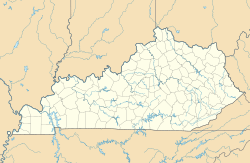Ashland (Henry Clay estate) facts for kids
|
Ashland
|
|

The front of the house
|
|
| Location | 120 Sycamore Road Lexington, Kentucky |
|---|---|
| Built | 1811 |
| Architect | Benjamin H. Latrobe; Thomas Lewinski |
| Architectural style | Italianate |
| NRHP reference No. | 66000357 |
Quick facts for kids Significant dates |
|
| Added to NRHP | October 15, 1966 |
| Designated NHL | December 19, 1960 |
Ashland is a historic estate in Lexington, Kentucky. It was once the home of Henry Clay, an important American leader from the 1800s. This large property was built and maintained by enslaved people. They worked the land, grew crops like hemp, raised animals, and took care of the Clay family's home.
Ashland is recognized as a National Historic Landmark. This means it's a very important place in American history. A famous horse race, the Ashland Stakes, held at Keeneland Race Course, is named after this historic estate.
Contents
The Story of Ashland Estate
Henry Clay moved to Lexington, Kentucky from Virginia in 1797. In 1804, he started buying land to create his large farm, or plantation, just outside the city. Over time, he became a major landowner, owning more than 600 acres. He also enslaved about 60 people who were forced to work on his property.
The Fight for Freedom: Charlotte Dupuy
Among the enslaved people at Ashland were Aaron Dupuy and Charlotte Dupuy, along with their children, Charles and Mary Ann. When Henry Clay went to Washington D.C. for his job in Congress in 1810, he took the Dupuy family with him. They were held there as enslaved people for almost 20 years.
In 1829, Charlotte Dupuy bravely sued Henry Clay for her freedom and the freedom of her two children. This happened 28 years before the more famous Dred Scott court case. The court told Charlotte to stay in Washington while her case was being decided. She lived there for 18 months, working for Martin Van Buren, who later became President.
When Henry Clay returned to Ashland, he took Aaron, Charles, and Mary Ann Dupuy with him. The court eventually decided against Charlotte Dupuy. When she refused to return to Kentucky willingly, Clay had her arrested. He then sent her to New Orleans, where she was held by his daughter and son-in-law for another ten years. Finally, in 1840, Henry Clay freed Charlotte and her daughter Mary Ann. Four years later, in 1844, he freed her son Charles.
The Mansion's Design and Changes
Henry Clay used the money from his farm, which was worked by enslaved people, to build his first house around 1806. It was built in the Federal architecture style. Between 1811 and 1814, he added two wings to the house. These were designed by Benjamin Latrobe, a famous architect.
However, the building materials used were not very strong, especially a type of brick that let water through. This made the house unstable. It was probably also damaged by the large New Madrid earthquake and its aftershocks in 1811–1812. Even with many repairs, Clay could never make the house completely stable.
Ashland's Later Owners
After Henry Clay passed away, his estate was divided among his three sons. His son, James Brown Clay, took ownership of Ashland and about 325 acres of land.
Rebuilding the Mansion
In 1854, James Clay decided to tear down the old house because it was unstable. He had a new house built in its place, which was finished by 1857. A local architect named Thomas Lewinski designed the new building. He used parts of the original house's design, like its shape and foundation, but he updated the style. The new mansion has many Italianate features, mixing the old Federal architecture style with new Italianate details.
Inside, James Clay decorated the home beautifully with Greek Revival features and fancy furniture bought in New York City. James Clay and his family lived in the rebuilt house until he died in 1864. His wife, Susan Jacob Clay, sold the estate in 1866.
University and Family Ownership
Kentucky University bought Ashland and used it as part of its campus. The university's founder, John Bryan Bowman, lived in the mansion. The Agricultural and Mechanical College (which later became the University of Kentucky) was located on Clay's former farm. During this time, John Bowman even used part of the mansion to display the University Natural History Museum.
Later, Kentucky University split into what became Transylvania University and the University of Kentucky. In 1882, Ashland was sold again.
Henry Clay's granddaughter, Anne Clay McDowell, and her husband, Henry Clay McDowell, bought the estate in 1883. They moved in with their children. They updated the house, adding gas lighting (and later electricity), indoor plumbing, and telephone service. Their oldest daughter, Nannette McDowell Bullock, continued to live at Ashland until she passed away in 1948. She started the Henry Clay Memorial Foundation, which bought Ashland to protect it. The historic house museum opened to the public in 1950, allowing visitors to learn about its history.
How Ashland Got Its Name
It's not completely clear if Henry Clay named his estate "Ashland" or if it already had that name. However, he was calling it "Ashland" by 1809. The name comes from the many ash trees that grew in the area. Henry Clay and his family lived at Ashland from about 1806 until his death in 1852. His wife, Lucretia Clay, moved out in 1854. Because of his political career, Henry Clay spent many years between 1810 and 1829 in Washington, D.C..
Several cities and towns across the United States were named in honor of this famous estate. These include Ashland, Kentucky, Ashland, Missouri, Ashland, Oregon, Ashland, Virginia, Ashland, Wisconsin, and Ashland, Pennsylvania.
See also



